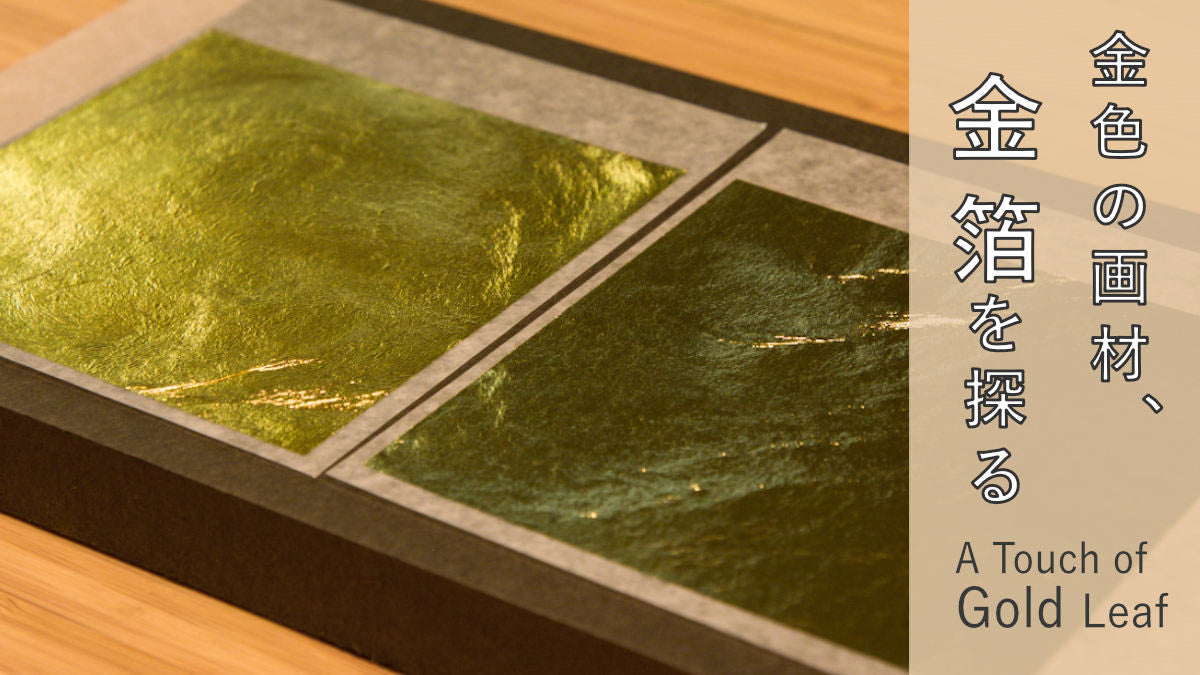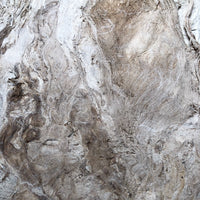What color do you imagine from the word "metal leaf"?
Gold leaf, which is probably the most used metal leaf in the world, which makes it the symbolic color of metal leaf.
And the second most widely used is the “silver leaf”.
However, several types of metal leaves appear silver in colors and are not 100% made of silver.
The reason for that is due to the properties of silver.
Perhaps many of you may share the same experience from your daily stuff like silver jewelry.
Therefore, it is difficult for sterling silver alone to retain its brilliance, such as producing silver leaves by containing different substances or with different manufacturing methods.
In the following article, I would like to introduce the silver-colored metal leaf and metal leaf that is made from silver.
◾️Silver Leaf
This is a true Silver Leaf made of 100% pure silver.
Therefore, its color will gradually change over time as the surface is exposed to air for a long period. The silver color is dignified and lustrous, as it is known as the name "Shirogane"or "Hakugin" which both means and is written "white silver / 白銀" in Japanese.
If you are looking for the graceful sheen and aging characteristic that only true silver can offer, this is the one for you!
◾️Non-discoloring Metal Leaf
This is 100% Platinum Leaf often used for decorative art objects. Since the metal leaf doesn’t discolor regardless of the surrounding circumstances, it is highly recommended for those who want to preserve the beauty of the silver color.
Its silver color has a warm white tone, as indicated by its alias of 白銀 (Shirogane or Hakugin, the white-silver).
◾️Discoloration-resistant Metal Leaf
Both of these metal leaves are more resistant to discoloration than silver leaves.
Aluminum Leaf may be easier to imagine since it is a metal we often use and see in our daily lives. It comes with a reasonable price and the metal leaf has a more subtle silvery luster.
On the other hand, Tin Leaf has a silver color with a slightly yellowish shade and a more subdued color than silver, platinum, or white gold leaves.
◾️Discoloration-resistant Metal Leaf that Fades
These Colored Silver Leaves are made from 100% pure silver, but they are color-coated with synthetic resin, dyes, and pigments. As a result, it is not easily discolored by oxidation, but the coloring will fade a little if exposed to light for a long time.
No.1 White Colored Silver Leaf and No.28 Grey Colored Silver Leaf are both silver in color but have the characteristics of colored silver leaves since they are color-coated.
We offer a total of 32 colors, including gold, red, blue, green, and black, so it is highly recommended to those who are looking for colored metal leaves.
【Colored Silver Leaves Catalogue】
◾️Discolorable Metal Leaf
Even though Silver Gold Leaf is not silver in color at first glance, its gold color is made of 100% silver.
Since it is made of discolored silver leaf, the characteristics of silver are inherited. Therefore, you can enjoy a different color transformation from the usual pure silver leaves.
On the other hand, White Gold Leaf is made of 50% pure gold and 50% pure silver. Due to its high silver content percentage, it inherits the properties of silver too.
It creates an intermediate color between platinum and tin but with a softer ivory tone of silver. I wonder what kind of color it will turn out to be over time!
Furthermore, these three metal leaves are also made of 100% pure silver.
The silver leaves were fumigated with sulfur to change the color of the silver itself and this sort of manufacturing technique is original to Japan.
While the silver leaf fumigates, it changes its color from red to purple, then to blue and black.
Therefore, each piece has different color changes, for example, the Blue Pearl Leaf changes from purple to blue, while the Red Pearl Leaf changes from orange to red to purple.
These metal leaves are carefully created through professional craftsmanship and you can sense it by the shimmering of colors.
Depending on how you expose these metal leaves to the environment, the color changes and progresses differently, so it would be interesting to consider and include that aspect in your artwork to observe the color-changing.
We can not prevent tarnishing of the metal leaves due to oxidation, although it is possible to delay the oxidation for a while if you apply it with dosa sizing.
It is important to note that the colors of Red Pearl Leaf and Blue Pearl Leaf will change significantly where the sizing solution is applied.
The following image shows the left side of each metal leaf without sizing and the right side with sizing over the metal leaf.

【Art Materials Used】
Substrate: Bamboo Washi for Watercolor Art Pad
Adhesive: Fish Glue for Sizing 20%, Alginate Liquid 1%
Metal Leaf: Blue Pearl Leaf, Red Pearl Leaf, Black Leaf, Silver Leaf
Sizing Solution on Metal Leaf: Fish Glue for Sizing (20% fish glue solution diluted to 1-1.5% with water)
【With/Without Sizing】
Left side of metal leaf: without sizing / Right side of metal leaf: with sizing
*Fish glue for sizing 20%...Sorry, this item is no longer available.
Pig glue for sizing can be used in the same way.
As you can see, except for the Silver Leaf, all other three have a distinct change in color.
Furthermore, these metal leaves were mounted on the papers and coated with sizing then were exposed to the air for about a year, so there are some changes over time too.
The color-changing of Red Pearl Leaf and Blue Pearl Leaf can be caused by any sizing liquids and mediums other than animal glue, however, the difference in it is more pronounced and noticeable with transparent mediums like fish glue.
Here’s a tutorial video for you to learn how to apply metal leaf.
We also have an IGTV on Instagram that explains the fumigated silver leaf, sizing liquids used for metal leaf and animal glue used for metal leaf application.
◾️【IGTV】 Fumigated Silver Leaf / 燻し銀箔
And for the million-dollar question, is it possible for the paint to fix after applying these metal leaves to your work?
Let's compare the results with using animal glue and gum arabic as mediums before and after applying ox gall to the metal leaves which is often used to prevent paints repel from the surface.
◾️Black Sumi Ink × Aluminum Leaf

【Art Materials Used】
Substrate: Kozogami Sarashi with Dosa Sizing (10 momme)
Metal Leaf: Aluminum Leaf
Paints: Daiwagaboku Hekitan Sumi Ink (double coats)
【With/Without Ox Gall & Application Method】
Left: Without Ox Gall
Center: Applied
Right: Mixed with the paint
*Daiwagaboku Hekitan...Sorry, this item is no longer available.
The higher the water content in dark Sumi ink, the more likely it will repel from the metal leaf. Therefore, it is better to choose the ink that is suitable to create a darker tone and make it thicker.
This time, when I tried it with the usual level of density, it repelled quite a bit, with or without ox gall, so I had to double the layer while painting it.
Moreover, I found that mixing ox gall with Sumi ink was more effective than using it as a base coat, although the outlines are still blurred in certain areas.
If you want to make it fixed even better on the metal leaf, remove the grease from the metal leaf by using a cotton ball covered with baby powder. Don’t forget to rub the powder completely off before painting.
◾️Gum Arabic x Aluminum Leaf

【Art Materials Used】
Substrate: Kozoshigami Sarashi with Dosa Sizing (10 momme)
Metal Leaf: Aluminum Leaf
Paints: Kissho Gunroku 13 (mineral pigment)
【With/Without Ox Gall & Application Method】
Left: Without Ox Gall
Center: Applied
Right: Mixed with the paint
As you can see from the picture, even though I didn’t double layer the mineral pigment, it fixed better than Sumi ink and the one from the far right, it seems to fix easier by pre-mixing with ox gall.
Nevertheless, the unexpected patterns created due to the repelling of water are also a beautiful surprise from the metal leaf. Please note that fixing strength is due to mediums and painting materials, therefore, remember to adjust the amount of paints according to your work and style.
For more information on the different types of gold leaf, feel free to check the following article out!

【PIGMENT ARTICLES】A Touch of Gold Leaf
Some of you may find the metal leaf techniques a bit too difficult for beginners, therefore, now in PIGMENT TOKYO, we offer workshops that even first-time users and children can enjoy!
◾️WEORKSHOPS

[Introduction to Metal Leaf]
Schedule: Once a month
Time: 14:00-15:30
Place: PIGMENT TOKYO
Reservation: WORKSHOP–PIGMENT TOKYO
*Click on the workshop page above for more.
Our popular metal leaf workshop is held regularly, therefore, you can now experience and explore new styles with the traditional Japanese technique of applying metal leaf!
I’m sure it would be such an amazing opportunity to learn while using the art materials with a professional instructor that you may take full advantage of and explore your new potential in this workshop.
Having Silver Leaf a "discoloration" as its characteristic may seem to be a disadvantage, however, it also gives infinite possibilities to your artwork. Perhaps knowing and using its uniqueness may open you up to a whole new world!
Translated by Atsumi Okano
PIGMENT TOKYO Art Materials Expert


















